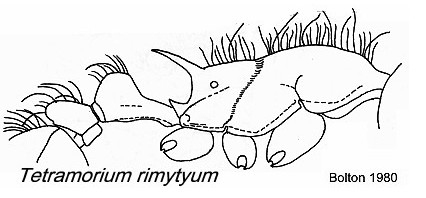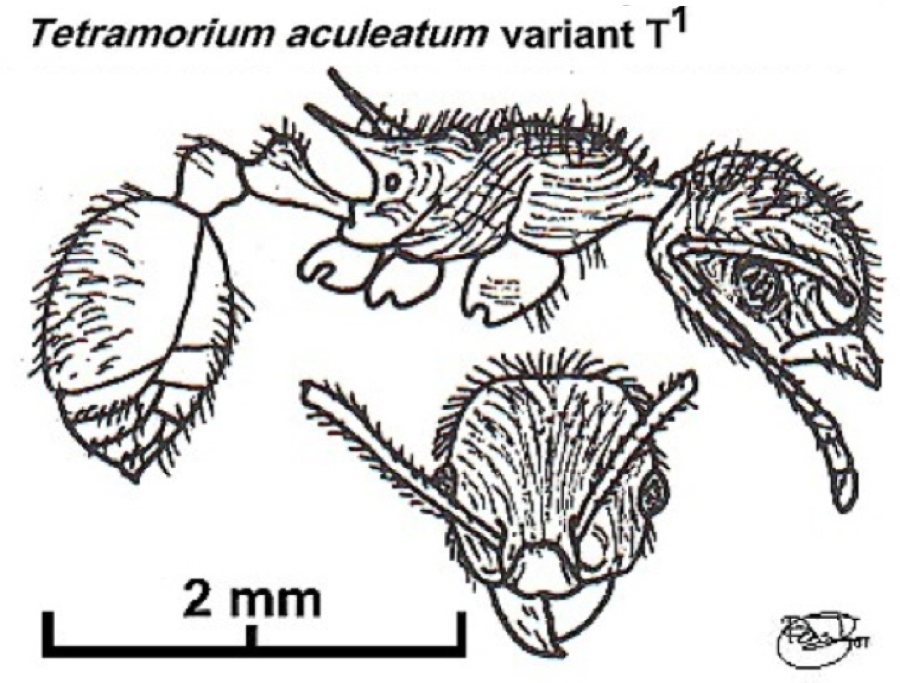Tetramorium rimytyum Bolton
  Type location Ghana
(Bolton, 1980, illustrated, alitrunk and pedicel, worker). Solely known
from the holotype described from his own collection at Mt. Atewa, where
he found it on a fallen tree trunk (1.xii.1968) Type location Ghana
(Bolton, 1980, illustrated, alitrunk and pedicel, worker). Solely known
from the holotype described from his own collection at Mt. Atewa, where
he found it on a fallen tree trunk (1.xii.1968)  . .
|
 Bolton's description (1980)
is at Bolton's description (1980)
is at  . .
WORKER - TL 4.8 mm; clypeus with conspicuous median
notch.
Antennal scrobes absent. Eyes prominent and hemispherical in full-face
view. Propodeum with long, narrow spines and conspicuous metapleural
lobes. Petiole with fairly long peduncle and domed profile, postpetiole
also domed but dome as if falling backwards. All dorsal surfaces with
abundant long, fine, acute hairs. Colour uniform dark brown.
According to Bolton, this is of some significance as an
intermediate between the aculeatum-group and the more obviously
typical Tetramorium types of the setigerum-group. If,
as seems the case, the specimen I separated out as Macromischoides species
Tą (see below) was determined by Bolton as no more than one of the
variants of Tetramorium
aculeatum [he lists a finding as "Onipe (B. Taylor)")]
then this species, based on a single specimen must be of questionable
status.
|

Tetramorium aculeatum (Mayr), colour variant
Nigeria specimens (as Macromischoides species
Tą, Taylor, 1979: 61). WORKER. TL 5.29 mm, HL 0.96, HW 1.12, SL 1.28,
PW 0.78
Colour very dark red-brown. Sculpturation rugoreticulate, rugae
dominant, on head and alitrunk, longitudinal except on dorsal pronotum,
where transversely arcuate, and oblique on the lateral mesonotum.
Abundant rather coarse long hairs all over. Mandibles with denticles
much reduced except the apical pair. Clypeus with spiculate central
area and anteriorly marginate. Frontal carinae of head short and no
antennal scrobes. Metanotal groove impressed; propodeum with a
pronounced anterior dorsal carina; propodeal spines noticeably curved
upwards but relatively short when compared to the common T.
aculeatum.
In Nigeria, I collected a single specimen from a vine on a
shade tree in a cocoa plot, Onipe 1/1, Plot C, at the Cocoa Research
Institute of Nigeria, Idi Ayunre. It is very distinctive in appearance
and is larger than the queen of the common T. aculeatum, which
was found on neighbouring cocoa trees. Thus, despite Bolton's
determination of it as aculeatum (personal communication,
1976), it seems to merit the separate treatment and the drawing. In
general the features all fit those described for the larger specimens
by Bolton (1980).
With the availability of the Antweb images, it can be seen that my drawing is a very close match to "rimityum", supported by my description.
|